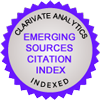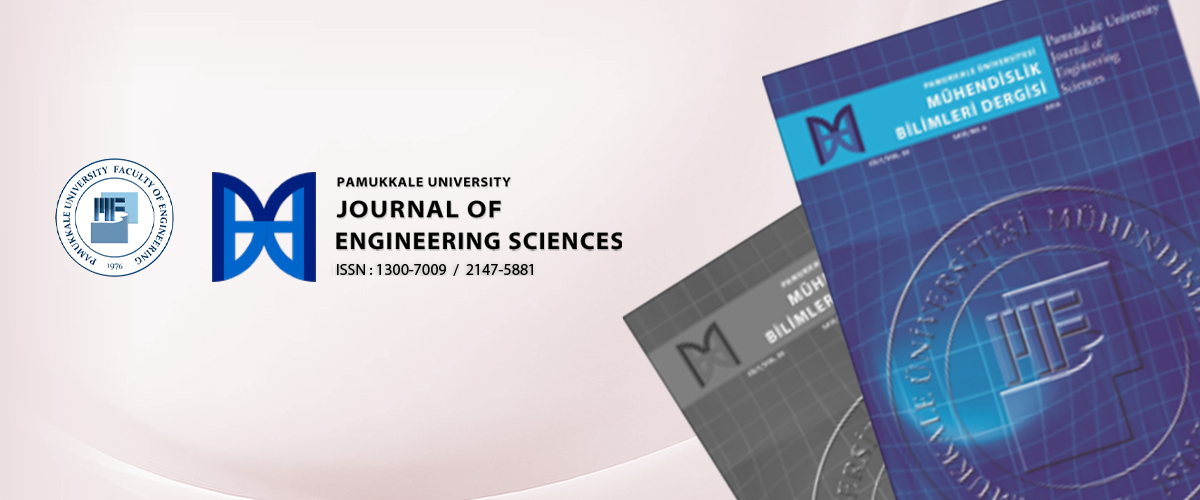Author Guideline
IMPORTANT NOTICE:
While uploading your manuscript to JournalAgent system, authors should provide the contact information of AT LEAST THREE potantial reviewers (from different institutions of the authors) at Reviewer Suggestion section given in Step 9.
Please note that the Editor-in-Chief has the right of not sending the manuscript to the suggested reviewers.
The PAJES manuscript template can be downloaded at:
http://pajes.pau.edu.tr/PAJES_Template_20160407_for_Authors.dotx
Abstract
This template contains the manuscript preparation guideline of Pamukkale University Journal of Engineering Sciences updated in December 2014. In this section a short abstract indicating the novelty and main findings of the work should be written. The text of abstract should be written fully justified, in italics and 8 pt. The abstract should include approximately 100-250 words and should not contain any non-common abbreviations and citations. The number of keywords should be between 3 and 6.
Introduction
Pamukkale University Journal of Engineering Sciences (PAJES) is a multidisciplinary journal that includes fundamental engineering areas. PAJES aims at disseminating recent advances in engineering and science to researchers, engineers and related readers. PAJES, in which both theoretical and experimental engineering studies take place, encourages the publication of the articles from challenging areas of engineering and concentrates on the publication of the interdisciplinary studies.
This template, which is prepared to help the authors, can be downloaded from the web site of the journal. The papers must be prepared in MS-Word® 2007 or its further releases.
Page Format
The preparation rules given below should be followed. It is recommended that you use this document as template in order to meet the specifications for the format of PAJES.
Page Layout
The size of the papers must be in A4 (210 x 297 mm). Margins must be 30 mm from top, 25 mm from bottom, 15 mm from left and 15 mm from right. Except for the title section of the paper, the page-width figures and tables, the main text must be in double columns 85 mm each. There must be a 10 mm space between the columns.
The main title of the paper should be written in both English and Turkish. The size of the title should be 14 pt and centered.
Only initial letters of the first names and whole of the surnames of the authors must be capital letters. There must be a 10 pt space after the full name of each author. Affiliations of the authors must be given in order of appearance and each individual affiliation must be given in a separate row together with the e-mails of the authors. If there are more than one author who have the same affiliation, their e-mail addresses should be given in order of their names. There must be an 8 pt space between the last e-mail address and the reception/acceptance date information of the paper.
Abbreviations should be spelled out in full at their first occurrence in the text.
Titles
All headings should be written in Cambria font. Level-1 headings must be bold, centered and 11 pt, and should begin with capital letters. Level-2, Level-3 and Level-4 headings must be in the same format as Level-1 headings but they should be 9 pt and justified to the left. No headings should be used further than level-4.
Fonts
Main text should be written in Cambria font and 9 pt, justified. In special cases, e.g. making an emphasis, italic or bold characters can also be used.
Equations
Each equation should be written in a separate row and be enumerated. Equations must be given in the 1x2 tables with hidden borders, where the width of the first cell is 90% and the width of the second cell is 10%. The equation in the first cell should be centered and the equation number in the second cell should be justified to the right. Left and right margins of the cells must be zero. All equations should be written in MS-Word® 2007 and further releases equation editor. Equations which cannot be fitted into a single row can be expressed in more than one row. When necessary, an equation can be given within the main text as long as it is shorter than a single row. Equation editor should be used also in the writing of the equations within the main text or the variables used in the equations. Numbers and their related units used in the text should be in the same line.
Figures
All figures should be centered in the column, but if a figure is large to the extent that it covers double column, then it should be centered according to the page. Figure captions must be below the figures as illustrated in Fig. 1.

Figure 1. An example figure.
If a figure is wider than a single column, it may be given as to cover two columns and it should be placed at the top or bottom of the page. All original or modified figures taken from other sources must be cited.
Tables
An example table is given in Table 1. Depending on the purpose of use, other types of tables can also be used in the text. Caption of the table should be given above the table.
Table 1. An example table.

If a table is wider than a single column it should be placed at the top or bottom of the page. All citations to the tables, figures and equations in the text must be expressed as in the template. If more than one tables, figures or equations are cited, punctuations of “,” and “-” can be used.
Hyperlinks
Hyperlinks can be used in the paper. Hyperlinks can be utilized as the links (documents, audio, multi-media etc.) that provide more information about the related topic. Font type of a hyperlink must be same as that of the main text but it should be underlined.
Page Numbers
Page numbers should not be inserted into the paper. Headers and footers should not be used in the paper. Such arrangements are to made by PAJES staff.
Citations
Citations in the text should be given by numbers in square brackets. The list of references should be given at the end of the paper in order of their first appearance in the text. Use individual sets of square brackets for citation numbers that appear together. For instance, the expression [1],[2],[5] cites the references 1, 2 and 5; similarly, the expression [3]-[9] cites all the references from 3 to 9. In this context, the section of references should be arranged as given in Section 5. In Section 5, [1],[2] correspond to peer reviewed journal papers, [3],[4] books, [5] section in book, [6],[7] conference proceedings, [8],[9] theses/dissertations, [10],[11] reports, and [12] internet hyperlinks.
Conclusion
This template can be downloaded from the web site (http://pajes.pau.edu.tr) of Pamukkale University Journal of Engineering Sciences (PAJES). Publishing Coordinators of PAJES thank to all authors for preparing their papers in conformity with this template.
Acknowledgment
Editors and Publishing Coordinators of PAJES thank to all authors and reviewers for their contributions.
References
- [1] Bennert T, Hanson D, Maher A. “Influence of Pavement Surface Type on Tire/Pavement Generated Noise”. Journal of Testing & Evaluation, 33(2), 94-100, 2005.
- [2] Erdoğan M, Tekin R, Kaya M. “Mikrodalga Fırında Suni Yaşlandırılan 6013 Alüminyum Alaşımın Korozyon Davranışının İncelenmesi”. Pamukkale Üniversitesi Mühendislik Bilimleri Dergisi, 20(1), 25-30, 2014.
- [3] Haupt RL, Haupt SE. Practical Genetic Algorithms. 2nd ed. New York, NY, USA, Wiley, 2004.
- [4] Erkek C, Ağıralioğlu N. Su Kaynakları Mühendisliği. Altıncı baskı. İstanbul, Türkiye, Beta, 2010.
- [5] Poore JH, Lin L, Eschbach R, Bauer T. Automated statistical testing for embedded systems. Editors: Zander J, Schieferdecker I, Mosterman PJ. Model-Based Testing for Embedded Systems, 111146, Boca Raton, FL, USA, CRC Press, 2012.
- [6] Li RTH, Chung SH. “Digital Boundary Controller for Single-Phase Grid-Connected CSI”. IEEE 2008 Power Electronics Specialists Conference, Rhodes, Greece, 1519 June 2008.
- [7] Yeğen B, Önöz B, Altıparmak B, Bilen O, Pala M. “Fırat, Yeşilırmak ve Kızılırmak Havzalarında Taşkınların Mevsimselliğinin Belirlenmesi”. Altıncı Ulusal Hidroloji Kongresi, Denizli, Türkiye, 22-24 Eylül 2010.
- [8] Boynukalın Z. Emotion Analysis of Turkish Texts by Using Machine Learning Methods. MSc Thesis, Middle East Technical University, Ankara, Turkey, 2012.
- [9] Ceylan H. Şehiriçi Ulaşım Ağlarının Armoni Araştırması Optimizasyon Tekniği ile Tasarımı. Doktora Tezi, Pamukkale Üniversitesi, Denizli, Türkiye, 2009.
- [10] Diament P, Lupatkin WL. “V-line Surface-Wave Radiation and Scanning”. Department of Electrical Engineering, Columbia University, New York, USA, Scientific Report, 85, 1991.
- [11] Devlet Planlama Teşkilatı. “Devlet Yardımlarını Değerlendirme Özel İhtisas Komisyonu Raporu”. Devlet Planlama Teşkilatı, Ankara, Türkiye, 2681, 2004.
- [13] Türk Standartları Enstitüsü. “Standart Arama”. https://intweb.tse.org.tr/standard/standard/standardara.aspx (21.12.2014).
Appendix A
Appendices should be given by classifying them. If necessary, they may begin on a separate page.







